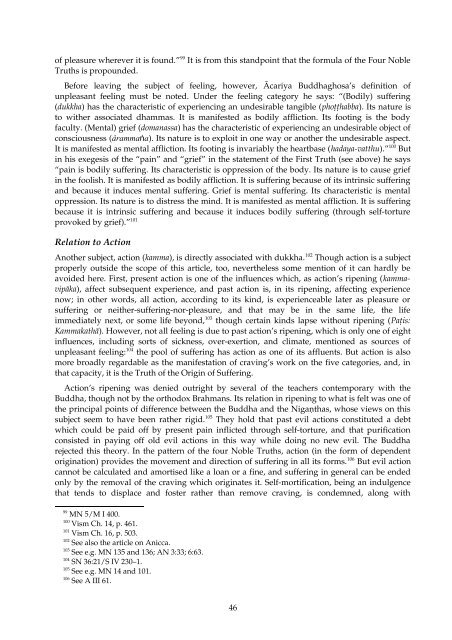The Three Basic Facts of Existence II: Suffering (Dukkha) - Buddhist ...
The Three Basic Facts of Existence II: Suffering (Dukkha) - Buddhist ...
The Three Basic Facts of Existence II: Suffering (Dukkha) - Buddhist ...
- No tags were found...
You also want an ePaper? Increase the reach of your titles
YUMPU automatically turns print PDFs into web optimized ePapers that Google loves.
<strong>of</strong> pleasure wherever it is found.” 99 It is from this standpoint that the formula <strong>of</strong> the Four NobleTruths is propounded.Before leaving the subject <strong>of</strong> feeling, however, Ācariya Buddhaghosa’s definition <strong>of</strong>unpleasant feeling must be noted. Under the feeling category he says: “(Bodily) suffering(dukkha) has the characteristic <strong>of</strong> experiencing an undesirable tangible (phoṭṭhabba). Its nature isto wither associated dhammas. It is manifested as bodily affliction. Its footing is the bodyfaculty. (Mental) grief (domanassa) has the characteristic <strong>of</strong> experiencing an undesirable object <strong>of</strong>consciousness (ârammaṅ a). Its nature is to exploit in one way or another the undesirable aspect.It is manifested as mental affliction. Its footing is invariably the heartbase (hadaya-vatthu).” 100 Butin his exegesis <strong>of</strong> the “pain” and “grief” in the statement <strong>of</strong> the First Truth (see above) he says“pain is bodily suffering. Its characteristic is oppression <strong>of</strong> the body. Its nature is to cause griefin the foolish. It is manifested as bodily affliction. It is suffering because <strong>of</strong> its intrinsic sufferingand because it induces mental suffering. Grief is mental suffering. Its characteristic is mentaloppression. Its nature is to distress the mind. It is manifested as mental affliction. It is sufferingbecause it is intrinsic suffering and because it induces bodily suffering (through self-tortureprovoked by grief).” 101Relation to ActionAnother subject, action (kamma), is directly associated with dukkha. 102 Though action is a subjectproperly outside the scope <strong>of</strong> this article, too, nevertheless some mention <strong>of</strong> it can hardly beavoided here. First, present action is one <strong>of</strong> the influences which, as action’s ripening (kammavipāka),affect subsequent experience, and past action is, in its ripening, affecting experiencenow; in other words, all action, according to its kind, is experienceable later as pleasure orsuffering or neither-suffering-nor-pleasure, and that may be in the same life, the lifeimmediately next, or some life beyond, 103 though certain kinds lapse without ripening (Paṭis:Kammakathā). However, not all feeling is due to past action’s ripening, which is only one <strong>of</strong> eightinfluences, including sorts <strong>of</strong> sickness, over-exertion, and climate, mentioned as sources <strong>of</strong>unpleasant feeling: 104 the pool <strong>of</strong> suffering has action as one <strong>of</strong> its affluents. But action is alsomore broadly regardable as the manifestation <strong>of</strong> craving’s work on the five categories, and, inthat capacity, it is the Truth <strong>of</strong> the Origin <strong>of</strong> <strong>Suffering</strong>.Action’s ripening was denied outright by several <strong>of</strong> the teachers contemporary with theBuddha, though not by the orthodox Brahmans. Its relation in ripening to what is felt was one <strong>of</strong>the principal points <strong>of</strong> difference between the Buddha and the Nigaṇthas, whose views on thissubject seem to have been rather rigid. 105 <strong>The</strong>y hold that past evil actions constituted a debtwhich could be paid <strong>of</strong>f by present pain inflicted through self-torture, and that purificationconsisted in paying <strong>of</strong>f old evil actions in this way while doing no new evil. <strong>The</strong> Buddharejected this theory. In the pattern <strong>of</strong> the four Noble Truths, action (in the form <strong>of</strong> dependentorigination) provides the movement and direction <strong>of</strong> suffering in all its forms. 106 But evil actioncannot be calculated and amortised like a loan or a fine, and suffering in general can be endedonly by the removal <strong>of</strong> the craving which originates it. Self-mortification, being an indulgencethat tends to displace and foster rather than remove craving, is condemned, along with99MN 5/M I 400.100Vism Ch. 14, p. 461.101Vism Ch. 16, p. 503.102See also the article on Anicca.103See e.g. MN 135 and 136; AN 3:33; 6:63.104SN 36:21/S IV 230–1.105See e.g. MN 14 and 101.106See A <strong>II</strong>I 61.46
















